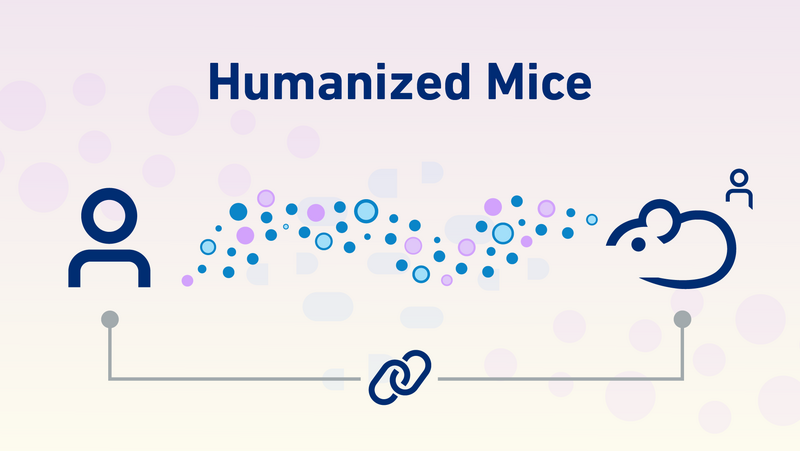What is a (JAX) humanized mouse?
Blog Post | February 13, 2025
What is a humanized mouse model? A seemingly straightforward question, with the most common answer – it depends. The term “humanized” can mean several things and depends on the context.
In the broadest sense, a humanized mouse refers to a mouse that carries some aspect(s) of human biology. For instance, “humanized” could refer to a mouse expressing a human gene introduced as a randomly-integrated transgene or targeted knock-in mutation. It could refer to a mouse expressing human immune cells, tissues, tumors, microbiota, etc. Humanized could also refer to a mouse expressing a combination of the above.
By expressing human components, humanized mice more accurately recapitulate aspects of human biology and pathophysiology compared to non-humanized mice and in vitro models. This enhanced accuracy allows for better translational modeling of human diseases and offers a more reliable platform to predict critical aspects of human responses to novel drug candidates. As a result, an increasing number of biomedical breakthroughs have utilized data from humanized mice for successful drug development and IND filing. 1,2
Given their utility and value, it is safe to assume the ways to “humanize” a mouse will continue to expand as new questions and technologies arise. The Jackson Laboratory currently offers several types of humanized mouse models to support your research. Below is a “cheat sheet” of our current humanized mice offerings.
JAX’s Humanized Mouse Models
Genetically Humanized: Nearly one-third of the mice in our repository are genetically humanized, meaning they express at least one human gene. These humanized mice provide a powerful platform for investigating the function(s) of specific human genes or genetic variations in health and disease, more accurately modeling human diseases, and testing therapeutics in a model that mimics more closely human physiology and pathophysiology than traditional mouse models. [Learn more] [Search JAX Mice]
CD34+ HSC Humanized: A CD34+ HSC humanized mouse is a model that lacks a functional murine immune system and has been engrafted with human hematopoietic stem cells (HSCs). These naïve human stem cells differentiate and mature into functional human immune cells within the mouse, creating a model that closely recapitulates key aspects of the human immune system in vivo. This platform supports long-term studies (over one year) facilitating the study of complex human immune cell interactions and the reliable testing of therapeutics with high human specificity. These immune cell humanized mice are a valuable tool for research in hematopoiesis, infectious disease, immunology, and immuno-oncology. [Learn More] [View JAX CD34+ HSC Models]
PBMC Humanized: A peripheral blood mononuclear cell (PBMC) humanized mouse is a mouse that expresses a human immune system via engraftment of mature human immune cells into a mouse lacking a functional murine immune system. Since the engrafted PMBCs matured within the human body, they recognize the mouse host as foreign and will mount a graft-versus-host (GvHD) response to mouse tissues. They can therefore be used to test potential immunosuppressive drugs for the prevention of GvHD. These mature immune cells are also capable of releasing cytokines in the presence of immunotherapeutics or cell therapies which can be measured to predict the likelihood of those therapeutics causing a toxic response in patients, known as Cytokine Release Syndrome (CRS). [Learn More] [View JAX PBMC Models]
Human Tumor-Bearing: Human tumor-bearing mice are immunodeficient NSG™ or NRG mice engrafted with human cancer cell line-derived xenografts (CDXs), or human solid or liquid tumors. JAX has a database of over 400 well-characterized solid patient-derived xenografts (PDXs), and 10 acute myeloid leukemia PDXs available for engraftment. These mice are a cost-effective, platform for proof-of-concept and target validation studies for drug development. [Learn More] [View JAX PDX Models]
Onco-Hu®: An Onco-Hu model is a mouse co-engrafted with human immune cells and a PDX or CDX. This co-engraftment offers a platform that recapitulates the clinical tumor microenvironment for mechanistic investigation and a more translatable investigation of the therapeutic potential of immunomodulatory drug candidates. In these Onco-hu models, researchers can examine the interactions between human immune cells and human tumor cells, offering much greater translational validity. [Learn More] [View JAX Onco-Hu Models & Services]
FcRn Humanized: An FcRn humanized mouse is a genetically humanized mouse engineered to exclusively express human neonatal Fc receptor (FcRn), an important recycling mechanism for regulating IgG antibody half-life. With accuracy comparable to that of non-human primate models, JAX’s FcRn humanized mice offer a fast (<14 days), accessible, and cost-effective platform to reliably predict the human pharmacokinetic (PK) profile of therapeutic antibodies. JAX has a suite of well-characterized FcRn mouse model variants to reliably support PK analysis of antibody-based therapeutics, Fc variants, and albumin conjugates which are the foundation of our HuPK portfolio. [Learn More] [View JAX FcRn Models & Services]
Atlas Mice for Antibody Discovery: Atlas mice are genetically humanized mice that have been engineered to generate when immunized, chimeric mouse-human antibodies that contain the near full complement of human antibody gene sequence diversity. These chimeric antibodies can then efficiently be engineered into fully human monoclonal or bispecific antibody therapeutics, accelerating your antibody drug discovery and development. [Learn More] [View JAX Atlas Mice]
References:
